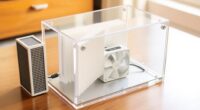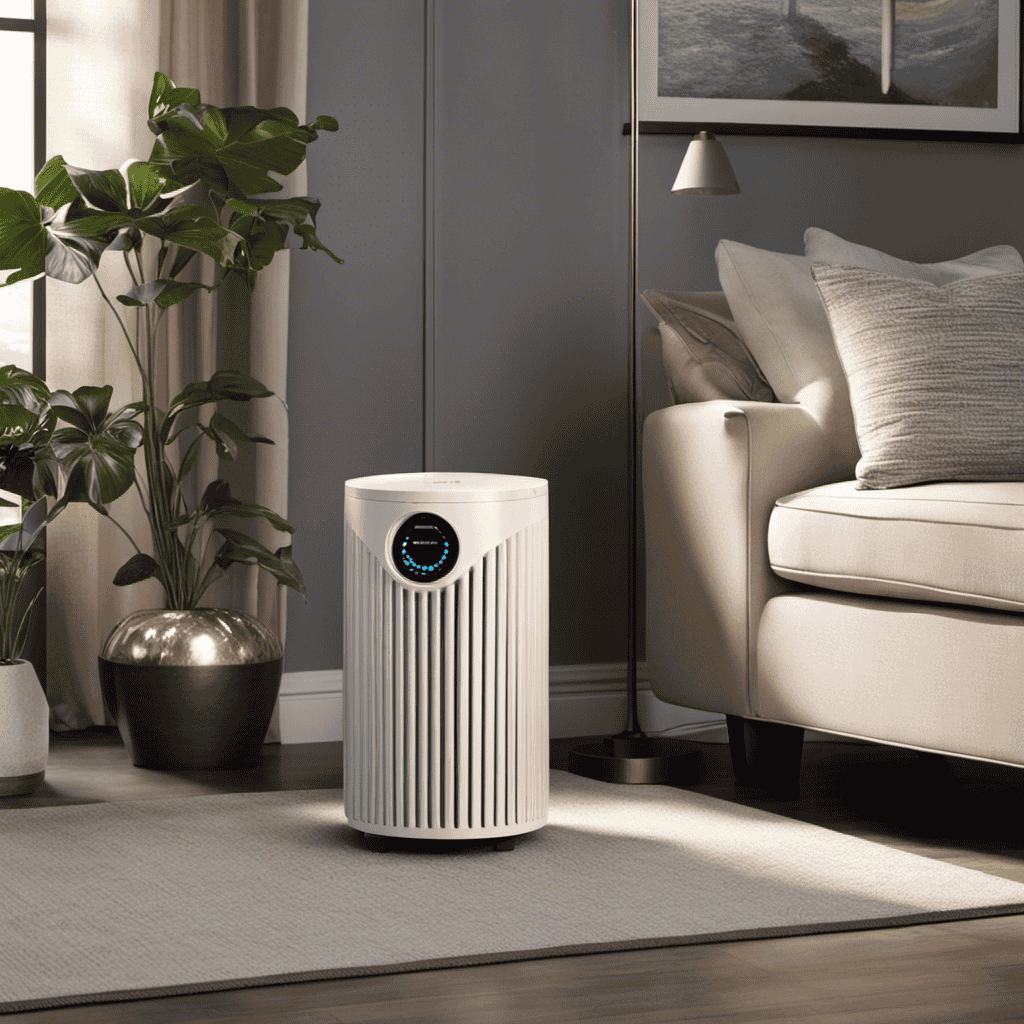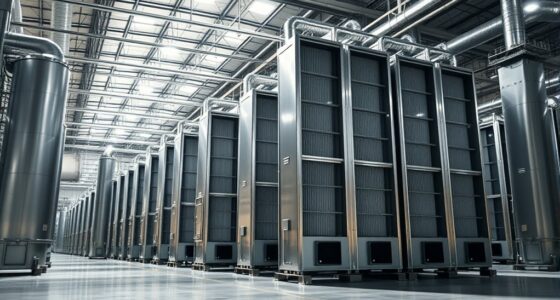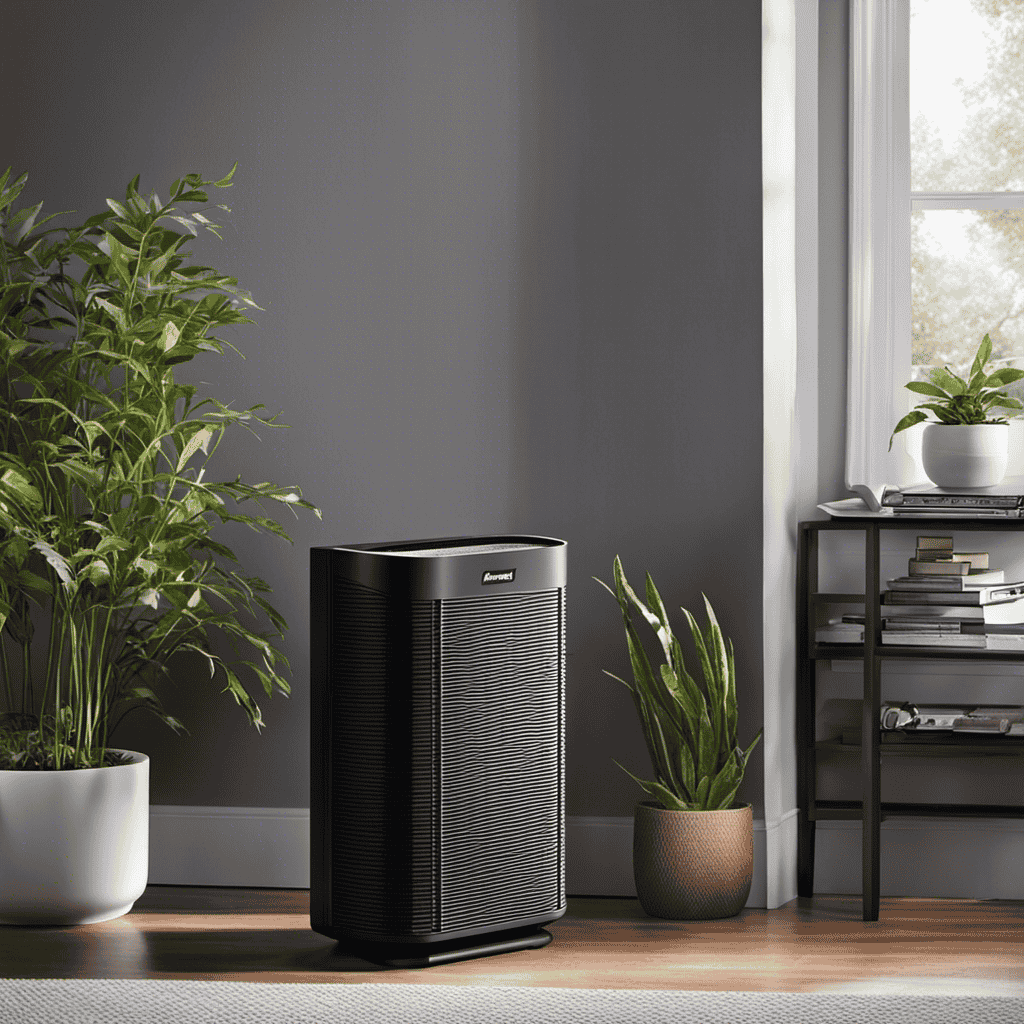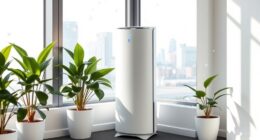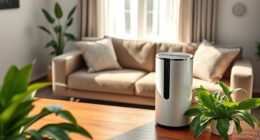HEPA filters work by trapping tiny particles like dust, allergens, bacteria, and viruses within dense, fibrous materials that create a maze for contaminants to get caught. They use mechanisms such as interception, impaction, and diffusion to capture particles as small as 0.3 microns. This makes HEPA filters highly effective at improving indoor air quality and supporting respiratory health. To discover more about their design and advantages, keep exploring how HEPA technology keeps your air cleaner.
Key Takeaways
- HEPA filters use dense fibrous materials to trap tiny particles, including bacteria and viruses, through physical mechanisms like interception and impaction.
- They effectively remove airborne contaminants such as dust, pollen, pet dander, mold spores, and microscopic pathogens.
- The dense fiber arrangement creates a maze-like structure that maximizes contact with particles, enhancing filtration efficiency.
- Regular maintenance prevents clogging, ensuring the filter maintains optimal performance and longevity.
- Advanced features like AI integration optimize filtration, capturing smaller particles and improving indoor air quality.
What Is a HEPA Filter and What Makes It Special
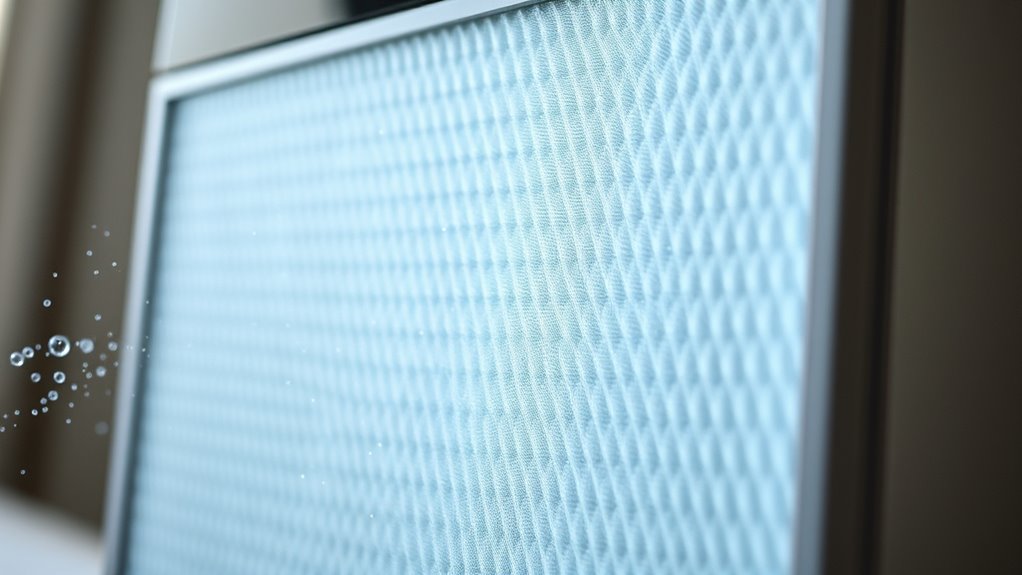
Ever wondered what makes a HEPA filter so effective at cleaning the air? The secret lies in its ability to trap tiny particles, including allergens, dust, and bacteria. HEPA filters are made of dense, fibrous materials that create a maze, capturing particles as air passes through. Proper HEPA filter maintenance is essential to keep it functioning at peak performance and extend its lifespan. Neglecting filter upkeep can cause it to clog faster, reducing efficiency and increasing the need for replacements. A well-maintained HEPA filter can last longer, ensuring cleaner air for months. Understanding this helps you appreciate why regular checks and timely replacement are crucial for maximizing the filter’s effectiveness and maintaining excellent indoor air quality. Additionally, selecting the right HEPA filter size and type can significantly impact its overall effectiveness and lifespan, especially considering filter performance depends on proper maintenance and usage. Regularly inspecting and replacing filters also supports the lifespan of the filter, ensuring it continues to provide optimal air purification over time. Proper maintenance of HEPA filters also helps prevent the buildup of contaminants, which can compromise air quality and the filter’s efficiency. Furthermore, advancements in technology are continually improving the ability of HEPA filters to capture smaller particles, enhancing their overall effectiveness.
The Science Behind Particle Capture

Understanding how HEPA filters trap particles starts with their ability to target different sizes and materials. You’ll see that filter material efficiency plays a key role in capturing both tiny particles and larger allergens. This science guarantees your air purifier works effectively to keep your air clean.
Particle Size Filtration
Particle size plays a crucial role in how HEPA filters capture airborne contaminants. HEPA filters are designed to trap a wide range of particles, including ultrafine particles smaller than 0.1 microns. These tiny particles are often difficult to remove with simple filters, but HEPA’s dense fibers increase the probability of interception. As particles pass through, they collide with fibers, get trapped, or are diverted into the filter media. Additionally, chemical filtration can enhance particle removal by neutralizing certain airborne chemicals and gases, working alongside physical filtration. This combination ensures that even the smallest contaminants are effectively captured, reducing health risks and improving air quality. Air quality can also be improved when airborne allergens and irritants are minimized. The effectiveness of HEPA filters depends on proper maintenance and regular replacement to prevent filter degradation, which can compromise filtration performance. Incorporating advanced filtration technologies can further optimize the removal of microscopic pollutants, including electrostatic attraction, which uses static charge to enhance particle capture.
Filter Material Efficiency
How do HEPA filters achieve such high efficiency in capturing particles? It all comes down to the quality of the filter material and its design. HEPA filters trap particles using four key mechanisms:
- Interception – particles stick to fibers when they come close.
- Impaction – larger particles collide directly with fibers.
- Diffusion – tiny particles move randomly, increasing chances of capture.
- Sedimentation – gravity causes particles to settle onto the filter.
The filter material’s density and fiber arrangement are vital for peak particle capture and filter longevity. A well-designed filter maintains high efficiency over time, even with accumulated particles. Proper maintenance and quality filter material ensure your air purifier stays effective longer, safeguarding your indoor air quality. Additionally, vetted filter materials are essential to ensure consistent performance and prevent the release of captured particles back into the environment.
Types of Particles Removed by HEPA Filters
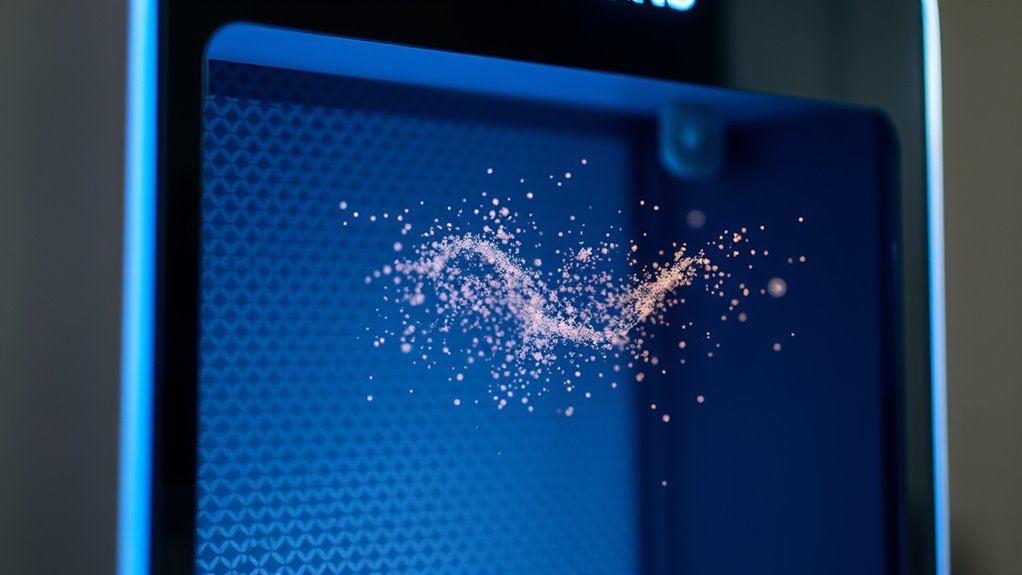
HEPA filters are effective at capturing a variety of airborne particles that affect your indoor air quality. They remove dust, allergens, pet dander, and even tiny bacteria and viruses. Understanding what they target helps you see how these purifiers can improve your environment. Additionally, HEPA filters are capable of trapping small particles as small as 0.3 microns, ensuring a thorough purification process. Recognizing air quality standards that meet safety guidelines can help you choose the most suitable air purifier for your needs. Moreover, the efficiency of HEPA filters can be influenced by filter maintenance, which is crucial for sustained performance.
Dust and Allergens
Have you ever wondered what types of dust and allergens a HEPA filter can capture? HEPA filters are highly effective at trapping tiny particles that cause allergy symptoms. Specifically, they remove:
- Airborne pollen, which triggers hay fever
- Mold spores, that can worsen respiratory issues
- Dust mites, common indoor allergens
- Pet dander, which often lingers in the air
These particles are usually too small to see but can considerably impact your indoor air quality. HEPA filters trap them efficiently, preventing them from circulating in your environment. Understanding filtration efficiency helps explain how these filters can improve indoor air quality. Additionally, proper filter maintenance ensures that the HEPA filters continue to perform at peak levels over time. Regularly replacing filters can prevent filter clogging and maintain optimal airflow. Proper maintenance not only enhances filter longevity but also ensures that the filtration process remains effective. As a result, you breathe cleaner air and reduce allergy symptoms. Incorporating spiritual practices like meditation can further enhance overall well-being and help manage stress related to allergies. This makes HEPA air purifiers a smart choice for anyone seeking relief from common indoor allergens.
Pet Dander Removal
Did you know that HEPA filters are highly effective at capturing pet dander particles? Pet dander is a common airborne allergen that can trigger allergy symptoms and asthma. These tiny particles are lightweight and easily become airborne, making them difficult to remove with regular cleaning. HEPA filters trap pet dander by forcing air through a dense mesh that captures particles as small as 0.3 microns. This means they can effectively remove airborne allergens caused by your pets, reducing the amount of pet dander circulating in your home. As a result, you breathe cleaner air and experience fewer allergy symptoms. If you have pets, using a HEPA air purifier is one of the best ways to manage pet dander and improve indoor air quality. Understanding indoor allergens can help you better appreciate the importance of effective filtration.
Airborne Bacteria and Viruses
Building on how HEPA filters effectively capture pet dander, they also play a vital role in removing airborne bacteria and viruses. These tiny pathogens can linger in your indoor air, risking health issues. HEPA filters trap particles as small as 0.3 microns, including:
- Airborne bacteria that can cause infections
- Airborne viruses responsible for illnesses
- Mold spores that trigger allergies
- Dust mites and pollen particles
Moreover, Natural Language Processing (NLP) technologies are increasingly being integrated into air quality monitoring systems to analyze and optimize the performance of filtration devices in real time. Advanced filtration techniques further enhance the ability of HEPA filters to capture a broader spectrum of harmful particles, ensuring cleaner indoor air. Understanding particle sizes helps explain why HEPA filters are so effective at trapping microscopic pathogens.
How HEPA Filters Are Designed for Maximum Efficiency
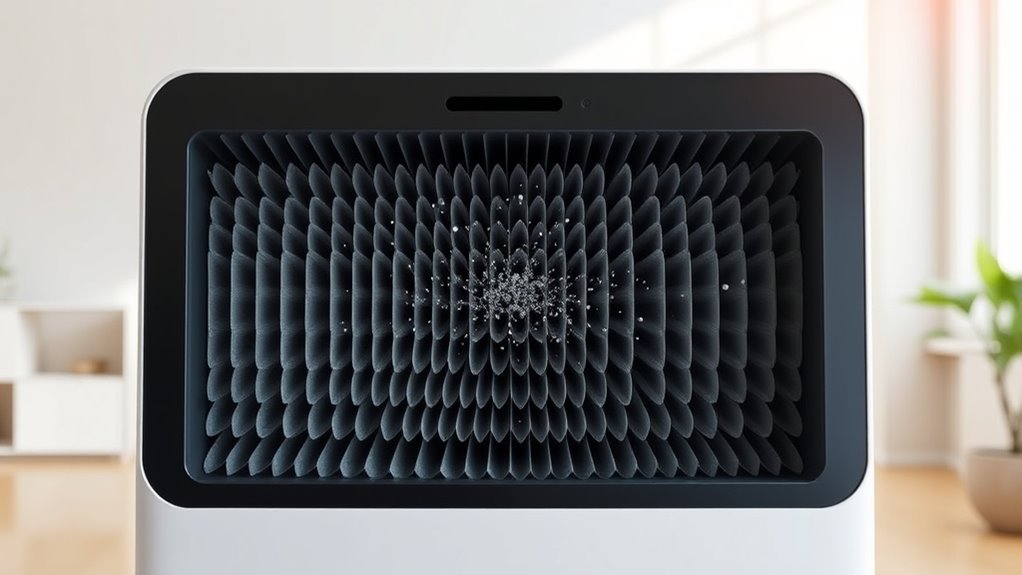
To maximize efficiency, HEPA filters are carefully engineered with a dense, tightly woven fiber matrix that captures particles as small as 0.3 microns. This design ensures ideal airflow enhancement, allowing air to pass through without significant resistance while trapping harmful particles. The arrangement of fibers creates a maze-like structure that increases the likelihood of particle contact and removal. Regular filter maintenance is essential to keep these filters working effectively; over time, dust and debris can clog the fibers, reducing airflow and filtration capacity. When you replace or clean your HEPA filter as recommended, you maintain peak performance, guaranteeing your air purifier continues to effectively remove airborne contaminants. Proper filter maintenance and upkeep are key to maximizing the filter’s efficiency in your space. Additionally, understanding the performance kits available for various Honda models highlights the importance of tailored upgrades for optimal vehicle performance. Moreover, integrating AI safety measures into air quality management systems can help monitor and optimize filter performance over time.
Comparing HEPA Filters to Other Air Purification Methods
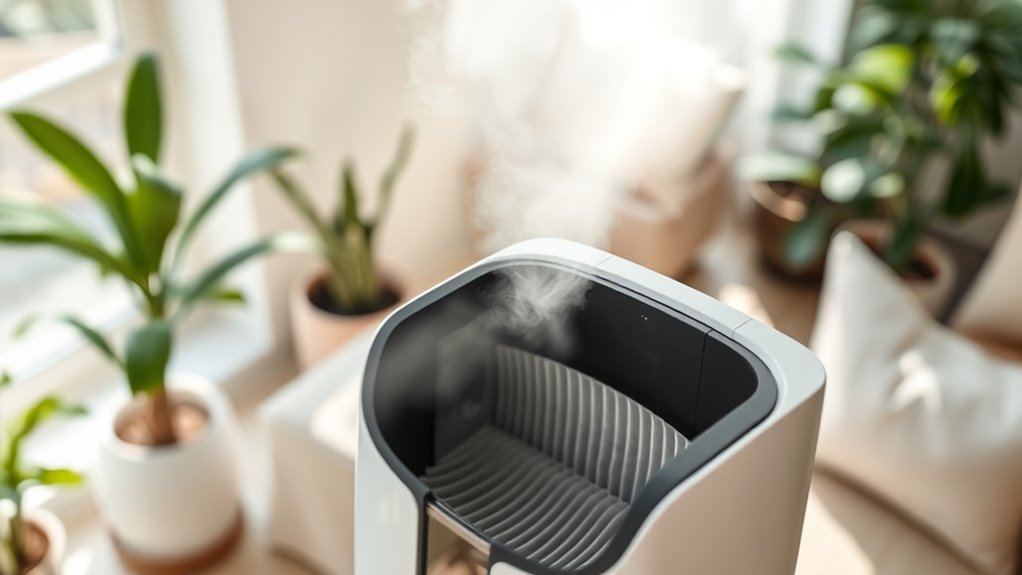
While HEPA filters excel at capturing particles as small as 0.3 microns, they are just one option among various air purification methods. When doing an air purifier comparison, it’s important to think about different filtration technologies. Here are four common options:
HEPA filters are effective but consider other filtration options for comprehensive air purification.
- Activated Carbon Filters – Absorb odors and gases effectively.
- UV Germicidal Irradiation – Uses UV light to kill bacteria and viruses.
- Electrostatic Precipitators – Charge particles for collection on plates.
- Ozone Generators – Produce ozone to neutralize pollutants (less recommended for indoor use).
Each method offers unique benefits, making it essential to weigh your specific needs when choosing an air purifier. Understanding these filtration technologies helps you make an informed decision.
Benefits of Using HEPA Air Purifiers in Your Space
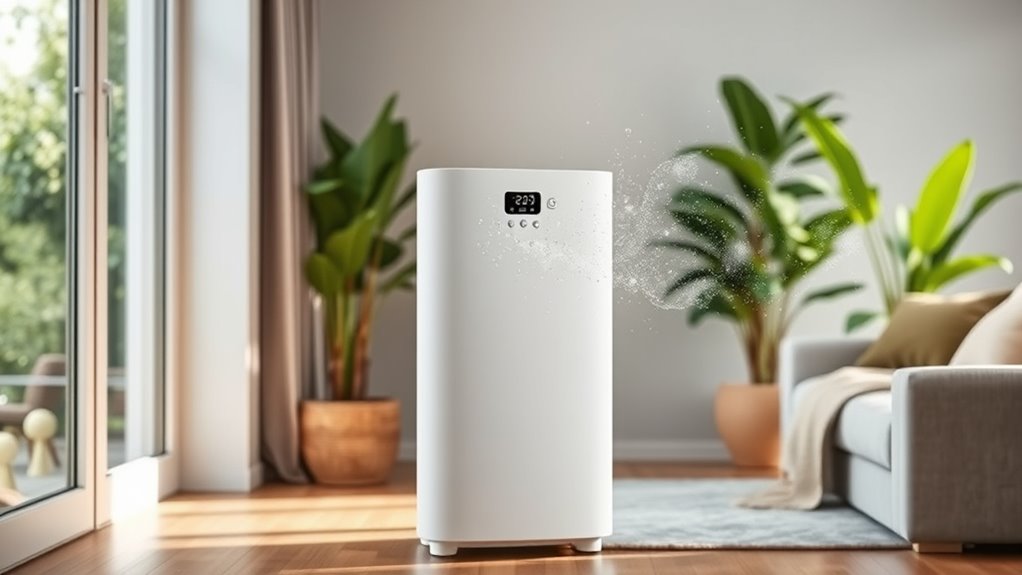
HEPA air purifiers offer numerous benefits that can considerably improve the air quality in your space. They effectively remove airborne contaminants like dust, pollen, pet dander, and bacteria, creating a healthier environment. This enhancement supports your respiratory health by reducing irritants that cause allergies and asthma symptoms. Using a HEPA filter can also decrease airborne viruses and mold spores, further protecting your well-being. Additionally, cleaner air can boost your overall comfort and productivity. Here’s a quick visual of these benefits:
| Benefit | Impact | Result |
|---|---|---|
| Improved air quality | Removes pollutants and allergens | Healthier breathing |
| Better respiratory health | Reduces allergy and asthma triggers | Less respiratory discomfort |
| Enhanced comfort | Creates a fresher, cleaner environment | Increased well-being |
Frequently Asked Questions
Can HEPA Filters Remove Viruses and Bacteria Effectively?
You might wonder if HEPA filters can remove viruses and bacteria effectively. They excel at viral filtration and bacterial removal by trapping particles as small as 0.3 microns with high efficiency. While they greatly reduce airborne pathogens, they don’t eliminate all viruses or bacteria, especially if the particles are smaller or if the filter isn’t maintained. Regular replacement and proper usage guarantee peak viral filtration and bacterial removal.
How Often Should HEPA Filters Be Replaced for Optimal Performance?
Ever notice how your air feels fresher after a while? That’s why you should pay attention to your HEPA filter’s lifespan and replacement frequency. Typically, you’ll want to replace your filter every 6 to 12 months for peak performance. Factors like usage and air quality can affect this, so check your manufacturer’s recommendations. Regular replacements keep your purifier working efficiently, keeping your indoor air cleaner and healthier.
Are HEPA Filters Effective Against Chemical Fumes and Odors?
You might wonder if HEPA filters handle chemical fumes and odors. While they excel at capturing particles like dust and allergens, they aren’t designed for chemical fumes or odors. For that, activated charcoal filters are more effective, as they absorb chemical fumes and odors through odor absorption. Using a purifier with both HEPA and activated charcoal filters provides exhaustive air cleaning, tackling both allergens and chemical pollutants efficiently.
Do HEPA Filters Work in Humid or Damp Environments?
While it’s tempting to think HEPA filters are invincible, humidity effects can influence their performance. In damp environments, moisture may reduce filter longevity and compromise efficiency, causing particles to cling or clog more quickly. Though they still trap airborne contaminants, you might notice a decrease in effectiveness over time. For ideal results, keep humidity levels moderate, and consider additional dehumidification to help your HEPA filter work better longer.
Can HEPA Filters Help Reduce Allergy or Asthma Symptoms?
Yes, HEPA filters can help reduce allergy and asthma symptoms. They trap airborne particles like pollen, pet dander, and dust mites that trigger allergy relief and asthma management. By filtering these irritants out of the air, you breathe easier and experience fewer symptoms. Keep in mind, using a HEPA air purifier consistently in your living space can markedly improve indoor air quality and support your health.
Conclusion
Now that you know how HEPA filters trap tiny particles and improve air quality, isn’t it worth choosing a purifier that guarantees cleaner, healthier air? With their proven efficiency and ability to remove allergens, bacteria, and more, HEPA air purifiers are a smart choice for your space. Don’t you want to breathe easier and enjoy a safer environment? Investing in one could make all the difference in your daily life.

